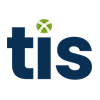[vc_row][vc_column][vc_column_text]Despite current economic headwinds, new research by TIS finds that treasury teams are planning to increase their overall headcount and invest in new technology during 2023. While is this generally good news for the industry, practitioners must be still be very strategic with how they pursue these staffing and technology initiatives. This is especially the case given added emphasis by business leaders on finding ways to cut costs and reduce operational expenses through years’ end.
Economic Uncertainty in 2023 Remains High
As we wind our way through the first quarter of 2023, most corporate treasury and finance practitioners would probably agree that the global business environment is in a precarious position.
Although overall U.S. and European inflation have fallen from their highs in 2022, business leaders continue to worry about the rising costs of goods, as well as the prospect of a global recession and various geopolitical risks. In fact, a recent research report by The Conference Board found that slow growth and recession are the greatest external concerns for C-suite executives in the year ahead.
To make matters worse, a tumultuous market often results in unpredictable staffing scenarios, especially when trying to hire and retain top talent. As we’ve seen recently, staff disruptions — including a recent slew of layoffs that have impacted the tech industry — have roiled corporate recruiting processes. And looking towards the next year, PwC’s Annual Global CEO Survey found that over half of respondents were still planning to reduce their operating costs in 2023, with 39% either already reducing headcount or planning to reduce it in the next 12 months.
However, despite the current uncertainty continuing to face organizations in the U.S. and across the globe, it appears that treasury practitioners are, in large part, fairing well amidst the turmoil. This is true both with regards to their staffing and recruiting prospects, as well as with their technology adoption priorities and planned spend.
Despite Broader Headwinds, Treasury’s Headcount is Set to Grow in 2023
Of course, most treasury teams are undoubtedly concerned about the challenges prevalent in today’s business environment. As evidence, preliminary results of NeuGroup’s 2023 Finance & Treasury Agenda Survey identified a prolonged economic slowdown as treasurers’ biggest concern heading into 2023, with 59% predicting that negative GDP growth will last through the end of the year.
But as new research by TIS has revealed, these challenges are not holding back treasury’s plans to invest in additional staff or acquire new technology.
In fact, TIS’ 2023 Treasury Priorities & Operations Survey, which polled the views of over 250 US finance and treasury practitioners over a 2-month span, found that only 3% expect to reduce their headcount in 2023. Instead, 48% plan to add more staff, and 49% will hold their staffing levels steady.
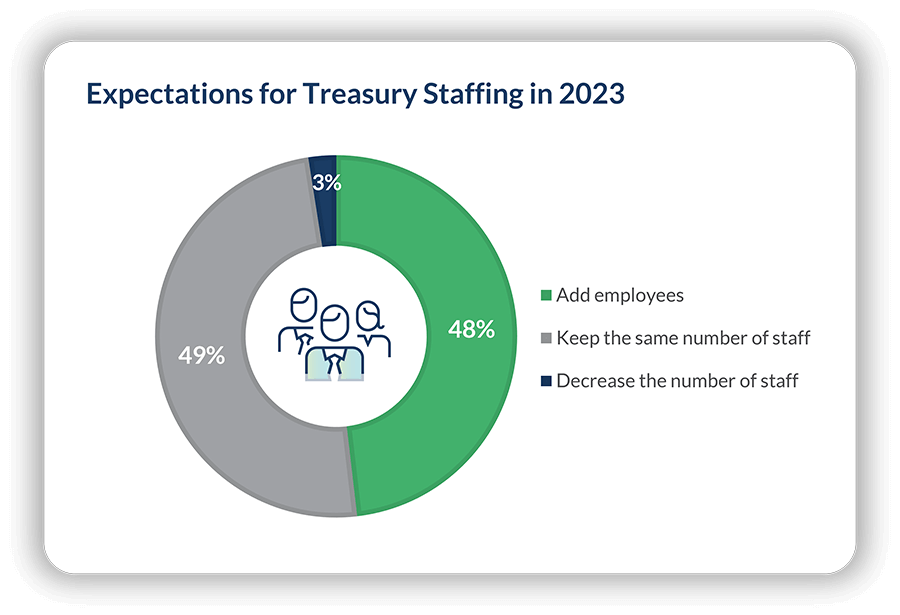
While these treasury staffing plans might seem to contradict logic given the current market, they are also evidence of the growing importance of treasury’s role internally. Although treasury teams have traditionally been kept lean, a renewed focus by business leaders is opening the door for more headcount.
In large part, data indicates that the rising strategic influence of treasury is helping boost their importance. In our study, 57% of treasury groups saw the strategic value of their department increasing in the months ahead compared with just 4% decreasing. And, 81% anticipated spending more time on strategic activities in 2023 compared to 2022. However, this growing strategic influence and renewed focus is also being accompanied by added expectations and responsibilities. In our survey, 77% of treasury teams expected their responsibilities list to grow or grow significantly in the coming year.
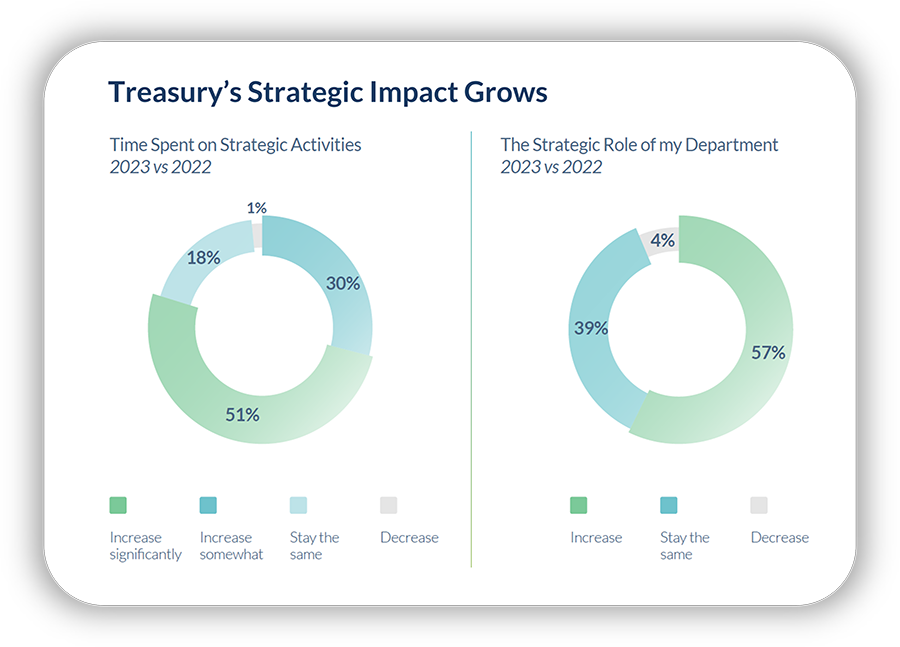
But while adding headcount may be a sign of an added emphasis on treasury by business leaders, data also indicates that a large component of the department’s strategic value is being derived through the application of enhanced technology. This includes the use of modern ERPs and TMSs, AI and machine learning (ML) tools, real-time payment solutions, and other types of improved data exchange protocols such as APIs.
Let’s take a closer look at this planned tech investment.
Investments in Treasury Technology Expected to Stay Elevated in 2023
Going off a combination of prominent industry studies and thousands of recent conversations with practitioners and consultants, it’s clear that technology adoption continues to be a major focus for treasury. Regardless of company size or industry, it seems that practitioners are collectively focused on either upgrading legacy TMS and ERP systems that have become obsolete, or moving beyond their manual excel and e-banking portal setup to achieve a more unified and streamlined structure.
Although cloud and SaaS platforms continue to be a major focus of these investments, other more “disruptive” capabilities involving AI, ML, and APIs are also being prioritized.
Based on TIS’ 2023 study, adopting solutions to improve cash forecasting and cash management functions are of critical importance, as are payments, bank connectivity, and working capital tools. In total, over 2/3rds of treasury teams indicated that forecasting and positioning were their top priority in Q1, and over half (55%) planned to invest in new cash management solutions within the year.
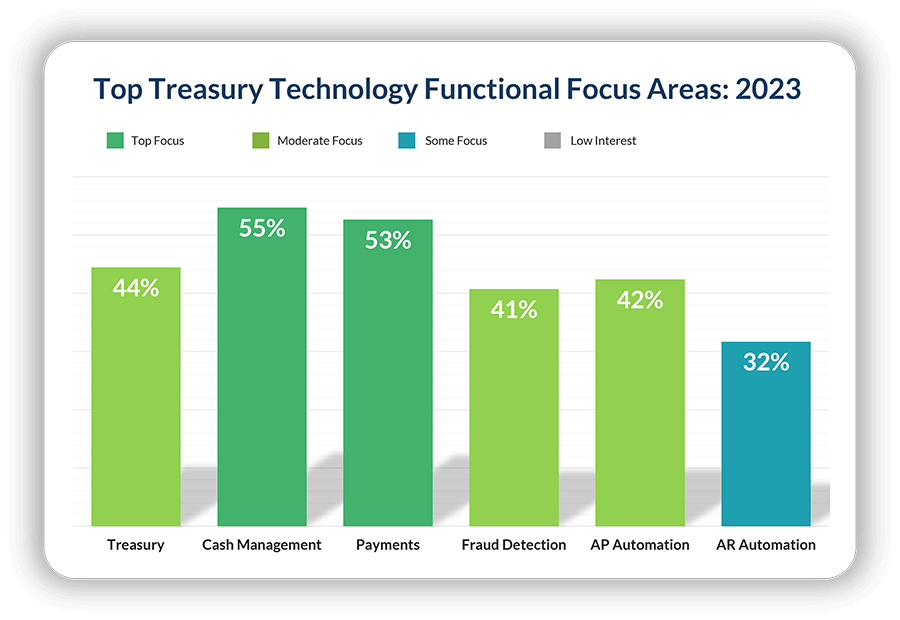
In addition:
- 73% of respondents were actively leveraging APIs for payments or bank reporting, and another 21% planned to integrate APIs for at least one of these capabilities by end-of-year.
- 63% expected to use real-time payment services by the end of 2023, up from 48% at the end of 2022.
- 51% expected to use AI by the end of 2023, up significantly from 27% at the end of 2022.
- 53% planned to use account validation and/or fraud prevention by the end of 2023.
- 47% planned to use virtual accounts by end-of-year 2023.
However, not all types of technology attracted high levels of interest from treasury teams. Notably, only one in five of all respondents – and just 13% of enterprise companies – expected treasury to use cryptocurrency by the end of the year. Given subdued market enthusiasm for crypto since 2022, coupled with several high-profile crypto bankruptcies and scandals like FTX, this hesitation is not entirely unwarranted.
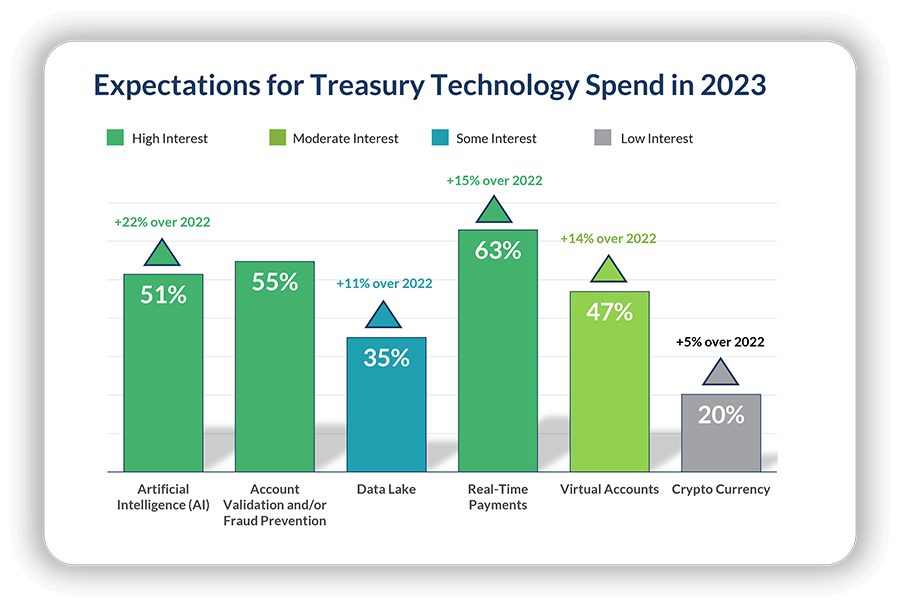
So then, given the clear inclination by treasury to continue investing significantly in new staff and technology during the next year, what is the best way for practitioners to ensure their investments reap the desired levels of productivity, efficiency, automation, and control?
Three Strategic Considerations for Treasury as They Hire More Staff & Invest in New Technology
Given the 2023 economic climate, organizations are becoming much more conscientious of their spend, and there is a heightened expectation from business leaders that treasury’s technology investments reap the desired benefits.
In order to manage these high expectations, the following tips can help treasury teams as they begin planning their technology budgets and strategies. To access a more complete list of questions and considerations, refer to this resource.
Know how to partner & collaborate with other internal stakeholders across the company.
Through discussions with thousands of practitioners who were actively considering or undergoing technology projects in the past year, one of the most consistent pain points identified involved gaining buy-in and approval from peers in other departments. In one sense, groups like accounting, AP, AR, treasury, and procurement are all competing for budget. At the same time, CFOs and business leaders only have a finite amount of capital that can be deployed. However, if these other internal groups can identify ways that treasury’s technology investments will boost their operations as well, then there is incentive for them to provide support. For this reason, it is imperative that practitioners be able to explain the benefits that their investments will have not only for themselves, but for the business at large. In addition, considering that groups like legal, HR, and IT will be involved in onboarding a new solution and helping manage integration and configuration tasks, it’s equally important to communicate with these personnel to prepare them for the project and plan for the proper amount of resources and effort to be allotted. Doing so up-front before the start of any project is the best way to ensure it stays on course.
Take time to understand the existing skillsets of your department and identify the areas where new skills would make the largest impact.
Given the traditionally small stature of corporate treasury teams, even the addition of a single employee can be a massive boost. However, treasury leaders should be prudent to carefully analyze the existing skills and talents of their team before adding new members. This will ultimately ensure a complimentary upgrade to the team, rather than a redundant one. This is especially important for teams of 3-4 members that may be expected to cover a range of functions like cash positioning, payments, forecasting, FX, debt and investments, data analysis, and more. Given the extent that technology is used on a daily basis, specialization with certain platforms like SAP® or various TMSs and Excel macros may also be required. But regardless of the unique setup at any specific company, the important point is that treasurers take the time to examine their existing team’s strengths and weaknesses in parallel with their outstanding operational requirements before they begin looking for the next hire.
Conduct a thorough audit of your existing technology stack before adopting new solutions to ensure that no redundancies are purchased & that each solution can integrate effectively with one another.
Regardless of the industry or complexity of a treasury group’s operations, it is a common theme for new technology to be purchased that is ultimately proven to be redundant or unnecessary in the long run. This is particularly the case for larger companies with numerous entities, ERPs, and other systems that may all be performing very similar functions for separate business units. At the same time, treasurers at smaller companies often unintentionally adopt capabilities as part of a new platform that they anticipate needing, but that ultimately go unused. For these reasons, before treasury adopts new technology, they should undergo a thorough audit of their existing systems to determine exactly where the gaps lie and where improvement is most needed. It’s likely that during this process, they will identify solutions that already exist within their structure that can be applied in place of a new capability. Or, they may discover that they can eliminate some of the solutions they have in place to make way for a newer and more advanced system. In either case, this regular “audit” of the tech stack is crucial during periods where software and digital ecosystems are evolving rapidly.
Final Thoughts: How Can TIS Help Your Treasury Team Improve in 2023?
As treasury groups evaluate their processes and recognize a need to improve their cash flow forecasting, bank connectivity, payments, or security and compliance workflows, we strongly encourage you to consider the innovative solutions and exemplary support structure offered by TIS.
Since 2010, our award-winning cloud platform and best-in-class service model have empowered the entire office of the CFO to collaborate more effectively and attain maximum efficiency, automation, and control. By streamlining connectivity between our customers’ back-office systems and their worldwide banks, vendors, and business partners, TIS enables users to achieve superior performance in key areas surrounding cash forecasting, working capital, outbound payments, financial messaging, fraud prevention, payment compliance, and more.
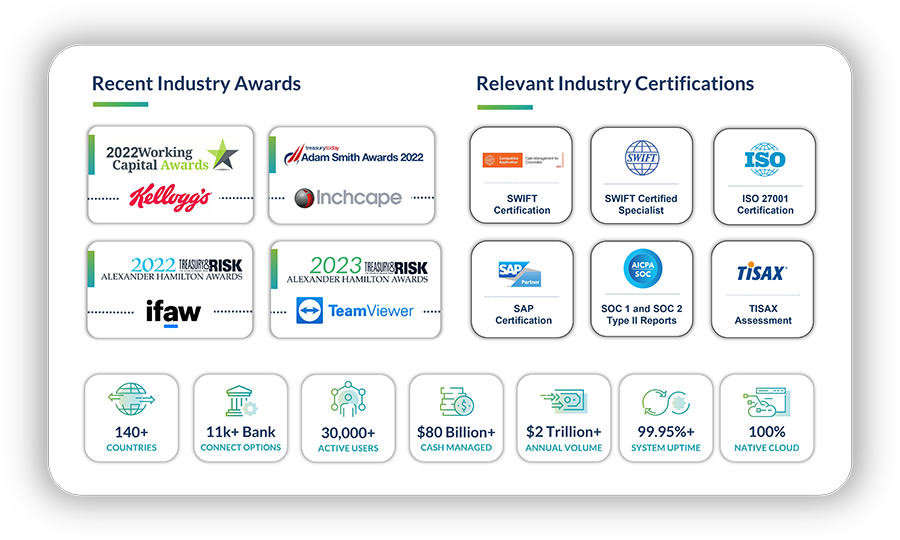
With over 11,000 banking options, $80 billion in daily cash managed, and $2.5 trillion in annual transaction volume, TIS has a proven track record of combining our unparalleled market expertise with tailored client and community feedback to drive digital transformation for companies of all sizes and industries. As a result, hundreds of organizations and thousands of practitioners rely on TIS daily to gain strategic advantage, monetize data, improve operational efficiency, and better manage risk.
For additional insights from our 2023 research initiatives, download the full survey report here.[/vc_column_text][/vc_column][/vc_row][vc_row][vc_column][vc_empty_space height=”128px”][/vc_column][/vc_row]
